A Quick Trip to Laos: Day 3 of 5 - Luang Prabang
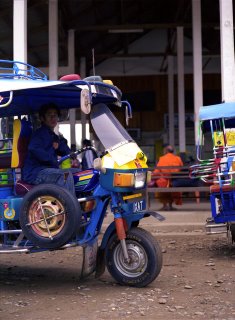 Welcome to Luang Prabang's dusty bus station. It's a very short ride into town and even though April is the start of the low season, the first two guest houses we hit were full. Makes you realize it's probably a very good idea to make reservations during the high-season. Our third guesthouse (Chantanome Guesthouse, +856+030-5140633, US$10/night) had a charming wood-panelled room with private bathroom that we took immediately.
Welcome to Luang Prabang's dusty bus station. It's a very short ride into town and even though April is the start of the low season, the first two guest houses we hit were full. Makes you realize it's probably a very good idea to make reservations during the high-season. Our third guesthouse (Chantanome Guesthouse, +856+030-5140633, US$10/night) had a charming wood-panelled room with private bathroom that we took immediately. No we didn't get much sleep on the bus but we still hit the streets as soon as we'd had cheese, baguette, coffee, eggs, and bacon. By then, kids where going to school. It was the last of them I saw, in uniform, so it must have been the last day of school before the New Year break. Just like Thailand, Laos' summer heat reaches its peak mid-April and the lunar year begins aknew around April 14th with week-long celebrations that include gigantic nation-wide water wars in the streets. As a sidenote, I just celebrated this in Bang Saen, Thailand, and you must imagine kilometers of traffic-jammed pick-ups loaded with huge tubs of water, everybody throwing that around with guns or simple bowls, and smearing each other's faces with talcum powder. Apparently Luang Prabang is the place to be for the "Pee Mai' in Laos(which means New Year, just like in Thai, but Thais call it Songkran). I can believe that because on the last day we were there, still 11 days from the three official days between April 13 to 15, people began throwing water! In Thailand, you can judge the intensity of Songkran fever in a particular place by how early it starts and how long it lasts (a mere two days in Phuket, weeks in Chiang Mai) but I never heard of anyone starting April 2!
No we didn't get much sleep on the bus but we still hit the streets as soon as we'd had cheese, baguette, coffee, eggs, and bacon. By then, kids where going to school. It was the last of them I saw, in uniform, so it must have been the last day of school before the New Year break. Just like Thailand, Laos' summer heat reaches its peak mid-April and the lunar year begins aknew around April 14th with week-long celebrations that include gigantic nation-wide water wars in the streets. As a sidenote, I just celebrated this in Bang Saen, Thailand, and you must imagine kilometers of traffic-jammed pick-ups loaded with huge tubs of water, everybody throwing that around with guns or simple bowls, and smearing each other's faces with talcum powder. Apparently Luang Prabang is the place to be for the "Pee Mai' in Laos(which means New Year, just like in Thai, but Thais call it Songkran). I can believe that because on the last day we were there, still 11 days from the three official days between April 13 to 15, people began throwing water! In Thailand, you can judge the intensity of Songkran fever in a particular place by how early it starts and how long it lasts (a mere two days in Phuket, weeks in Chiang Mai) but I never heard of anyone starting April 2!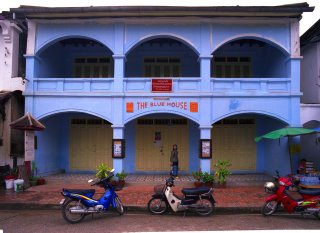 The Blue House, Th Sisavangvong.
The Blue House, Th Sisavangvong.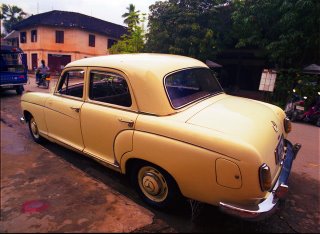 The Car from Naga Guesthouse, Th Sisavangvong.
The Car from Naga Guesthouse, Th Sisavangvong.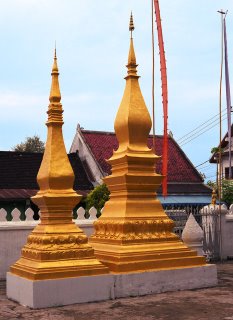 Stuppas at Wat Saen, Th Sisavangvong.
Stuppas at Wat Saen, Th Sisavangvong.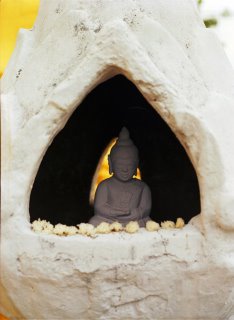 Buddha in lotus flower, Wat Saen, Th Sisavangvong.
Buddha in lotus flower, Wat Saen, Th Sisavangvong.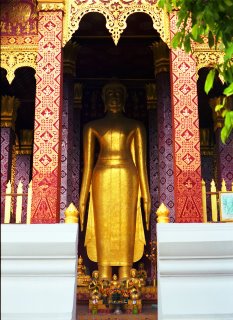 Standing golden Buddha, Wat Saen, Th Sisavangvong.
Standing golden Buddha, Wat Saen, Th Sisavangvong. One of the many upscale restaurants in Luang Prabang and its "falang" owner, Th Sisavangvong.
One of the many upscale restaurants in Luang Prabang and its "falang" owner, Th Sisavangvong.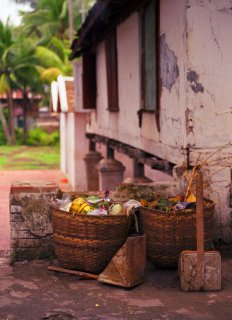 Whicker garbage cans and half-jerrycan dust trays, Th Sisavangvong.
Whicker garbage cans and half-jerrycan dust trays, Th Sisavangvong. This lion looks like a messy eater but for having seen how the novice monks do their painting chores, the red paint on this little fellow is still pretty neatly applied.
This lion looks like a messy eater but for having seen how the novice monks do their painting chores, the red paint on this little fellow is still pretty neatly applied.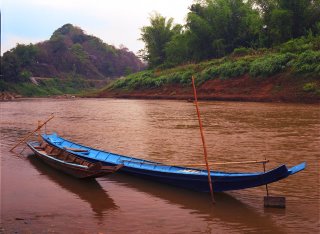 Fishing boat on Nam Khan, an affluent of the Mekong that runs on the South-Eastern side of Luang Prabang before meeting the Mekong at its northernmost tip. Nam Khan and the Mekong give Luang Prabang its peninsular shape and that very special feeling that comes from being in sight of water at all times.
Fishing boat on Nam Khan, an affluent of the Mekong that runs on the South-Eastern side of Luang Prabang before meeting the Mekong at its northernmost tip. Nam Khan and the Mekong give Luang Prabang its peninsular shape and that very special feeling that comes from being in sight of water at all times. The temple on the Royal Palace grounds that contains the Pha Bang, a standing Buddha of gold after which Luang Prabang is named.
The temple on the Royal Palace grounds that contains the Pha Bang, a standing Buddha of gold after which Luang Prabang is named.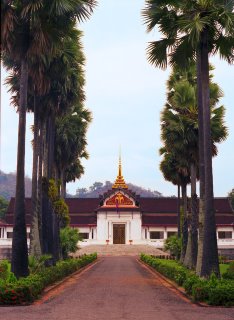 This very blunt shot of the palace does nothing to render the beauty of the place. The museum (no pictures allowed) it contains is exceptional as well. It contains religious sculptures and objects belonging to the royal family of Laos or their retainers. Some of its rooms are still as they would have been when the palace was inhabited. Between it and the mountain that serves as its backdrop on this picture lies the Mekong while Phu Si mountain is behind us. The last of the royal family disapeared in 1975 in Northern Laos.
This very blunt shot of the palace does nothing to render the beauty of the place. The museum (no pictures allowed) it contains is exceptional as well. It contains religious sculptures and objects belonging to the royal family of Laos or their retainers. Some of its rooms are still as they would have been when the palace was inhabited. Between it and the mountain that serves as its backdrop on this picture lies the Mekong while Phu Si mountain is behind us. The last of the royal family disapeared in 1975 in Northern Laos.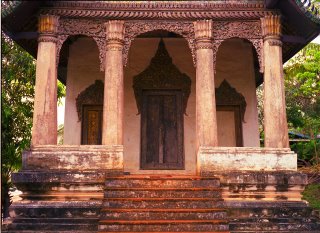 Wat Pha Huak, across from the Royal Palace, at the foot of Phu Si.
Wat Pha Huak, across from the Royal Palace, at the foot of Phu Si. The gardeners are kind enough to trim the trees so that every tourist who comes to Luang Prabang can take the same shot of the Royal Palace from the top of Phu Si mountain, beneath the stupa of That Chomsi.
The gardeners are kind enough to trim the trees so that every tourist who comes to Luang Prabang can take the same shot of the Royal Palace from the top of Phu Si mountain, beneath the stupa of That Chomsi.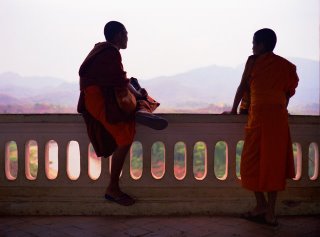 Two novice monks overlook the Mekong from the top of Phu Si mountain, at Wat Tham Phu Si, next to a small cave where one can see an imprint of the Buddha's foot. Once I looked at the picture I had to wince. Taking pictures really makes a rushed Japanese tourist of you. When this picture came up from the scanner onto my screen, it struck me what a stunningly beautiful and calm place to be this mountaintop must have been. Unfortunately, I remember only wondering how I could ever fit such a wide range of light and dark in one picture. The answer is low contrast Fuji 160S negative film by the way and a pretty lucky exposure setting. Come to think of it, the most fun I had on this trip was after I smashed my camera! But this kind of picture--even if it's an insult to the rule of thirds--makes it all worth it because it's a magic moment captured for eternity.
Two novice monks overlook the Mekong from the top of Phu Si mountain, at Wat Tham Phu Si, next to a small cave where one can see an imprint of the Buddha's foot. Once I looked at the picture I had to wince. Taking pictures really makes a rushed Japanese tourist of you. When this picture came up from the scanner onto my screen, it struck me what a stunningly beautiful and calm place to be this mountaintop must have been. Unfortunately, I remember only wondering how I could ever fit such a wide range of light and dark in one picture. The answer is low contrast Fuji 160S negative film by the way and a pretty lucky exposure setting. Come to think of it, the most fun I had on this trip was after I smashed my camera! But this kind of picture--even if it's an insult to the rule of thirds--makes it all worth it because it's a magic moment captured for eternity.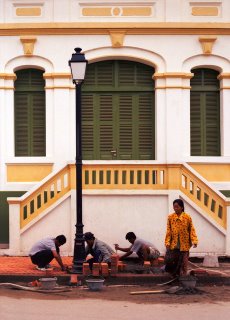 There is a lot of restoration work going on in Luang Prabang, particularly on the sidewalks while we were there. They are all made of diagonally interlocking bricks and visibly this is true to tradition as I could see the same brick motif under peeling tar on yet unrestored streets. This work is financed by the UNESCO and the Agence Francaise pour le Development. Every bit of construction has its sign reading who paid for it (the two I have just named) and how much it costs; usually around one to two thousand US dollars.
There is a lot of restoration work going on in Luang Prabang, particularly on the sidewalks while we were there. They are all made of diagonally interlocking bricks and visibly this is true to tradition as I could see the same brick motif under peeling tar on yet unrestored streets. This work is financed by the UNESCO and the Agence Francaise pour le Development. Every bit of construction has its sign reading who paid for it (the two I have just named) and how much it costs; usually around one to two thousand US dollars. Senior monk and his novices at Wat Pha Phuttabaht. On top of the considerable investments made by the UNESCO to restore his temple, this monk also has his novices working hard to upkeep the place. He kindly showed us around the temple and told us about this past studies in Chiang Mai (Thailand). The UNESCO also has a school in Luang Prabang to train skilled laborers in the restoration and preservation of Luang Prabang's past.
Senior monk and his novices at Wat Pha Phuttabaht. On top of the considerable investments made by the UNESCO to restore his temple, this monk also has his novices working hard to upkeep the place. He kindly showed us around the temple and told us about this past studies in Chiang Mai (Thailand). The UNESCO also has a school in Luang Prabang to train skilled laborers in the restoration and preservation of Luang Prabang's past.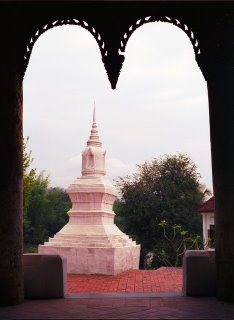 View from inside Wat Pha Phuttabaht.
View from inside Wat Pha Phuttabaht. Old colonial home on Th Sisavang Vathana.
Old colonial home on Th Sisavang Vathana.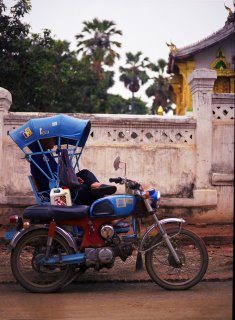 On the street along the Royal Palace that goes down to the pier on the Mekong.
On the street along the Royal Palace that goes down to the pier on the Mekong.That's all for today. Day 4 takes us an hour's boat ride down the Mekong to a cave overlooking its waters that is crammed with Buddhas and then 25km out of town to the milky turquoise waters at the foot of a giant waterfall.

1 Comments:
That shot of the two young monks is magic! :-)
Just one thing: you need to do something about how you embbed your images in the text, it's very confusing at the moment.
There is a way to use the align command on the image, let your text flow next to it, and then when you want, make the rest of the text jump to the next image.
I don't know how to display html code in a comment, but if you google style="clear" you should get a pretty good idea what I'm talking about. (I use style="clear:both;" in my template to prevent floating images from exceeding the bounds of a post if there is not enough text alongside them, but there may be issues with the sidebar with that one, I'm not sure since I don't have a sidebar!)
Or just ping me on IM ;-)
Post a Comment
<< Home